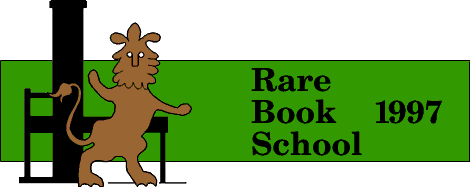
|
Week One |
| 11 | History of the Printed Book in the West (Session I). Early printed books; printing processes; bookbinding; typography and book design; publishing, reading, and the book trade; the book in America and American books; book illustration; C19 mechanization of the printing trades; C20 fine printing. Intended for those with no prior coursework or extensive reading in the field. Offered again in Week 2 (see no. 22). Instructor: Martin Antonetti. See the Expanded Course Description. | ||||||||||||||||||
.
.
.
.
.
|
|
Week Two |
| 21 | Introduction to Codicology. The principles, bibliography and methodology of the analysis and description of Western medieval and Renaissance manuscripts. Survey of the development of the physical features of manuscript books from the C5 to the C15. This is a course for non-specialists, but applicants must have considerable background in the historical humanities; an introductory knowledge of Latin and some previous exposure to paleography will be a recommendation. Instructor: Albert Derolez. See the Expanded Course Description. | ||||||||||||||||||
.
.
.
.
.
|
|
Week Three |
| 31 | Introduction to Medieval and Early Renaissance Bookbinding Structures. An explanation of the diversities of European bookbinding structures, up to and including the early period of more generalized practice and divisions of labor. Topics include: identification (where possible) of the main types of binding structures; their dating and provenance; the recognition and recording of materials and techniques. Instructor: Christopher Clarkson. See the Expanded Course Description. | ||||||||||||||||||
.
.
.
.
.
|
|
Week Four |
| 41 | The Use of Physical Evidence in Early Printed Books. The use of a wide variety of evidence paper, type, rubrication and illumination, bindings, ownership marks, and annotations to shed light both on questions of analytical bibliography, and wider questions of book distribution, provenance and use. There will be a fairly detailed discussion and analysis of both good and bad features in existing reference works on early printing. The seminar assumes a basic knowledge of descriptive bibliography and some familiarity with Latin. Instructor: Paul Needham. See the Expanded Course Description. | ||||||||||||||||||
.
.
.
.
.
|